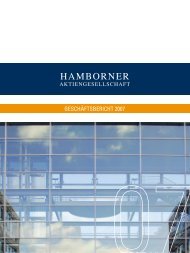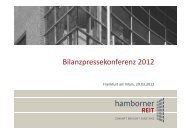annual report 2009 - bei der Hamborner REIT AG
annual report 2009 - bei der Hamborner REIT AG
annual report 2009 - bei der Hamborner REIT AG
You also want an ePaper? Increase the reach of your titles
YUMPU automatically turns print PDFs into web optimized ePapers that Google loves.
to our sHareHol<strong>der</strong>s management <strong>report</strong> Financial statements supplementary inFormation<br />
52 <strong>Hamborner</strong> reit ag | <strong>annual</strong> <strong>report</strong> <strong>2009</strong><br />
Valuation risk<br />
The retention of value of our properties is checked <strong>annual</strong>ly using the generally recognised<br />
DCF process. We had the valuation for our commercial property portfolio carried out by an<br />
independent third party again at the end of <strong>2009</strong>. Detailed information on the valuation of<br />
our property portfolio can be found in the section "Performance of the portfolio". A need for<br />
extraordinary depreciations to the extent of €0.7 million ensued in the financial statements<br />
in accordance with IFRS for the <strong>2009</strong> financial year on the basis of the valuations carried<br />
out. On the other hand, a reversal of impairment adjustment amounting to €1.3 million was<br />
made for a total of nine properties subjected to non-scheduled depreciation in previous<br />
years. Influences may arise on the valuation of properties in the future as well by the application<br />
of different discount interest rates as a result of changes in the general risk assessment,<br />
the interest rate level or property-specific risks.<br />
Financial Risks<br />
The asset and financial structure of our company is still extremely sound. Financial liabilities<br />
and <strong>der</strong>ivative financial instruments amounted to €113.7 million at the end of the <strong>report</strong>ing<br />
year. The balance sheet equity ratio of the company in individual financial statements in<br />
accordance with IFRS amounts to 52 % at the end of the year un<strong>der</strong> review. For the financing<br />
of our growth, additional borrowed funds will also be raised in the future to an appropriate<br />
extent. Therefore, the development of the interest rate level is of corresponding importance<br />
for the company. In or<strong>der</strong> not to be subject to short-term interest rate risks, we have financed<br />
our investments at terms fixed for the long term, via interest rate hedges in some cases. You<br />
will find further details on the interest rate hedging transactions in the notes to the financial<br />
statements un<strong>der</strong> the section "Financial liabilities and <strong>der</strong>ivative financial instruments".<br />
The risks resulting from the financial instruments relate to credit, liquidity and market risks.<br />
Credit risks exist in the form of risks of default for financial assets. This risk subsists to the<br />
extent of the book values of the financial assets as a maximum. For <strong>der</strong>ivatives, this is the sum<br />
of all the positive market values and, for primary financial instruments, the sum of the book<br />
values. If risks of default exist, they are taken into account by means of value adjustments.<br />
Liquidity risks constitute refinancing risks and thus risks of a fulfilment of existing obligations<br />
to pay when due. The strategy and the results of the planning process are taken as<br />
a basis for the early identification of the future liquidity situation. The expected liquidity<br />
requirements are scheduled in the medium-term plan, which covers a period of five years.<br />
With registration of the new Articles of Association, HAMBORNER is retroactively a <strong>REIT</strong><br />
public limited company as of January 1, 2010. As such, it is exempt from German corporation<br />
and trade tax. Un<strong>der</strong> the <strong>REIT</strong> status, therefore, the tax risks quoted in the past due to<br />
the "interest barrier" or the claiming of the "prerogative of extended trade tax reduction"<br />
do not apply for the company.<br />
In or<strong>der</strong> to maintain the <strong>REIT</strong> status over a long period, the company has to comply with<br />
precisely laid down criteria. This includes above all the fact that the free float must be at<br />
least 15 %, no investor may directly hold more than 10 % of the shares, at least 75 % of the<br />
assets must rank among the immovables, 90 % of the year-end result in accordance with<br />
the German Commercial Code is to be distributed and the equity capital may not fall below<br />
45 % of the fair value of the immovables. We counteract the risk of losing the <strong>REIT</strong> status by<br />
means of our internal monitoring and controlling system. We monitor the development of<br />
the decisive ratios for the classification as a <strong>REIT</strong> company, particularly the development of<br />
the <strong>REIT</strong> equity ratio in accordance with Section 15 of the German <strong>REIT</strong> Act [<strong>REIT</strong>G], which<br />
at 67.2 % on the <strong>report</strong>ing date of December 31, <strong>2009</strong> is consi<strong>der</strong>ably above the required<br />
minimum equity ratio of 45 %.





